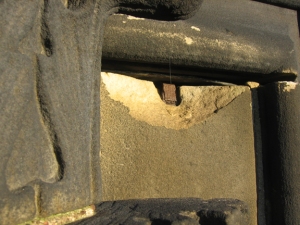Each week we’re bringing you an in-depth look at one of the standard conditions we encounter and document during inspections of buildings and civil structures.
Part 3: Spalls
Spalling is the mechanism by which shear stresses within masonry or concrete force pieces of the material to break away. This process is sometimes referred to as bursting. The resulting piece of loose material is called a spall. Incipient spalls are not yet fully-formed. Bonded spalls are fully formed, but remain attached to the surrounding masonry, typically by mortar or sealant. Missing spalls may expose metal anchors or other ferrous embedments.
Spalling is a mechanical action that can have various root causes. Water infiltration causes spalling through the destructive action of freeze-thaw cycles. The use of inappropriate repair materials or mortars can cause spalling by introducing a material with a different rate of thermal expansion than the adjacent material. When reinforcing steel, metal anchors, lintels or embedments are exposed to moisture, the rust that forms expands in volume, forcing apart the masonry or concrete in which it is located. Natural flaws in stone; manufacturing defects in brick, concrete or terra cotta; poor design (for example, too-narrow masonry joints); or improper installation (such as wood shims left in place) can also contribute to spalling.
Next in this series: Efflorescence and Leached Salts
Click here to see all posts in this series.
Click here for an index of all posts in this series, or download a pdf of the complete series.


